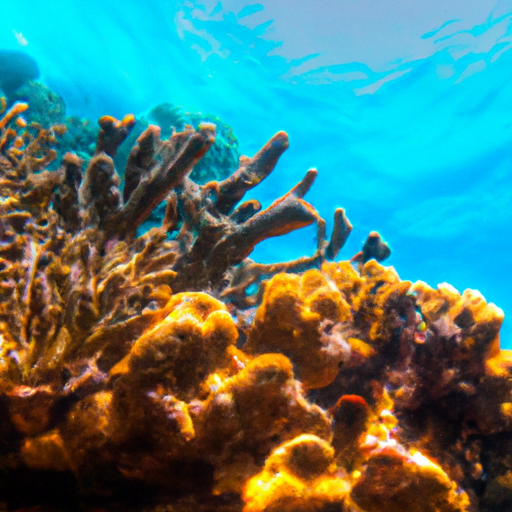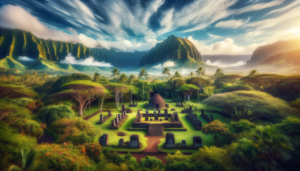Are you ready for an unforgettable adventure through the stunning natural wonders of Hawaii’s diverse ecosystems? From the lush rainforests teeming with vibrant flora and fauna to the mesmerizing coral reefs bursting with colorful marine life, Hawaii offers an exceptional opportunity to delve into the magic of nature. Join us on a journey through these awe-inspiring landscapes and discover the secrets they hold, as we unlock the beauty and serenity of Hawaii’s diverse ecosystems.
Table of Contents
ToggleExploring the Natural Wonders of Coral Reef Hawaii’s Diverse Ecosystems
Hawaii is not only known for its stunning beaches and vibrant culture but also for its diverse and lush ecosystems that offer breathtaking natural wonders. From magnificent rainforests to mesmerizing coral reefs, this tropical paradise is a haven for nature enthusiasts. Whether you are an avid hiker, a snorkeling enthusiast, or simply someone who appreciates the beauty of the natural world, Hawaii has something for everyone. Let’s embark on an adventure through Hawaii’s diverse ecosystems and discover the awe-inspiring wonders that await.
Rainforests in Hawaii
Hawaii’s rainforests are a testament to the island’s rich biodiversity. These verdant havens are teeming with life, providing a home for countless species of plants and animals. Haleakala National Park, located on the island of Maui, is a prime example of Hawaii’s vibrant rainforest. With lush foliage, cascading waterfalls, and breathtaking views, this park is truly a paradise for hikers and nature enthusiasts.
Another must-visit rainforest is the Hawaii Volcanoes National Park on the Big Island. This park is home to the world’s most active volcano, Kilauea. The rainforest surrounding the volcano is thriving with unique plant species, such as the famous ‘Ōhiʻa Lehua tree. Explore the park’s hiking trails, witness the power of nature, and immerse yourself in the beauty of the rainforest.
Koke’e State Park on the island of Kauai offers a different rainforest experience. As you wander through the park’s lush trails, you’ll be surrounded by towering trees and vibrant ferns. The park also boasts stunning viewpoints overlooking the Napali Coast, providing visitors with an unparalleled experience of Hawaii’s natural beauty.
If you find yourself on the island of Kauai, don’t miss a visit to Waimea Canyon State Park. Known as the “Grand Canyon of the Pacific,” this magnificent site is a testament to the erosive power of water and time. The vibrant greenery of the surrounding rainforest contrasts with the vibrant red and orange hues of the canyon, creating a breathtaking landscape that will leave you in awe.
Coral Reefs and Marine Life
Hawaii’s crystal-clear waters are home to some of the most diverse and vibrant coral reefs in the world. These underwater sanctuaries provide shelter for a myriad of marine species and offer unparalleled snorkeling and diving opportunities.
Hanauma Bay Nature Preserve on the island of Oahu is a must-visit spot for snorkeling enthusiasts. With its calm and shallow waters, this preserve allows visitors to witness the vibrant coral formations up close. Dive into the turquoise waters and swim among tropical fish, sea turtles, and colorful corals, making unforgettable memories.
For a unique diving experience, head to Molokini Crater, a partially submerged volcanic crater off the coast of Maui. The crystal-clear waters surrounding the crater boast an abundance of marine life, including tropical reef fish, coral colonies, and even the occasional manta ray.
Maui Ocean Center is another destination perfect for exploring Hawaii’s marine life without getting wet. This world-class aquarium showcases the diverse ecosystems found in the surrounding waters. From mesmerizing coral gardens to playful Hawaiian green sea turtles, visitors can marvel at the beauty of Hawaii’s marine world and learn about the importance of conservation efforts.
There are numerous other snorkeling and diving spots scattered across the islands, each offering a unique experience. Whether you choose to explore the colorful coral gardens in Hanauma Bay or swim with the gentle giants at Molokini Crater, Hawaii’s marine life will leave you captivated and inspired.
Volcanic Landscapes
The volcanic landscapes of Hawaii are a testament to the powerful forces that have created and shaped these enchanting islands. From towering volcanic peaks to flowing lava, the raw beauty of Hawaii’s volcanic landscapes is truly awe-inspiring.
The Big Island of Hawaii is home to some of the most active volcanoes in the world. Volcanoes National Park is a must-visit destination for those eager to witness the primal forces of nature at work. Explore the park’s diverse landscapes, hike through ancient lava fields, and marvel at the glowing lava flows, creating new land right before your eyes.
On the island of Maui, Haleakala Crater offers a unique volcanic experience. This dormant volcano is home to a stunning lunar-like landscape. As you hike through the crater, you’ll feel like you’ve been transported to another world. The panoramic views from the summit are simply breathtaking, especially if you catch the sunrise or sunset.
Hawaii’s volcanic landscapes also include mesmerizing lava fields and lava tubes. These natural wonders can be found throughout the islands and offer a glimpse into the geological history of Hawaii. Explore the unique formations of hardened lava and walk through lava tubes, ancient tunnels formed by flowing lava.
Kilauea Iki Crater, located within Volcanoes National Park on the Big Island, offers a unique perspective on Hawaii’s volcanic landscapes. This crater is a remnant of a massive eruption in 1959 and now serves as a popular hiking destination. Witness firsthand the power of nature as you take a walk across the solidified lava lake, a surreal experience that showcases the ever-changing nature of Hawaii’s volcanic landscapes.
Waterfalls and Rivers
Hawaii’s lush rainforests and dramatic topography give rise to numerous majestic waterfalls and rivers. These natural wonders not only provide scenic beauty but also essential water sources for the island’s ecosystems.
Wailua Falls, located on the island of Kauai, is one of the most iconic waterfalls in Hawaii. With its double-tiered drop and surrounded by lush greenery, this breathtaking cascade is a sight to behold. An overlook near the falls offers a stunning vantage point, allowing visitors to take in the full splendor of this natural wonder.
Akaka Falls State Park, also on the Big Island, is home to another captivating waterfall. The park’s lush rainforest trails lead visitors to Akaka Falls, a towering cascade that plunges 442 feet into a pool below. The awe-inspiring power of the falls combined with the scenic beauty of the surroundings creates a memorable experience for nature lovers.
Wailuku River State Park on the Big Island is a haven for travelers seeking a tranquil escape. The park’s main attraction is Rainbow Falls, named for the rainbows that often appear in the mist created by the rushing water. Take a stroll along the walking paths, breathe in the fresh air, and let the soothing sounds of the river wash away the stress of everyday life.
On the island of Kauai, the Hanalei River and Bay offer a different kind of water experience. Take a kayak or paddleboard along the calm river and immerse yourself in the serene beauty of your surroundings. Marvel at the lush greenery that lines the riverbanks and enjoy the peacefulness of this hidden gem.
Coastal Areas and Beaches
Hawaii’s stunning coastal areas and beaches are world-renowned for their natural beauty and pristine waters. From rugged cliffs to powdery white sands, the coastal regions of Hawaii offer a diverse range of landscapes for visitors to explore.
The Na Pali Coast on the island of Kauai is one of the most picturesque coastal areas in Hawaii. With its towering cliffs, emerald valleys, and dramatic waterfalls, this untouched paradise is a true natural wonder. Explore the coast by hiking the Kalalau Trail or take a boat tour to witness the breathtaking beauty from a different perspective.
Lanikai Beach on the island of Oahu is consistently ranked among the top beaches in the world. With its powder-soft sand and crystal-clear waters, this idyllic beach is a haven for beachgoers and water sports enthusiasts alike. Bask in the warmth of the sun, take a refreshing dip in the ocean, and soak in the beauty of Lanikai’s tranquil shores.
Waikiki Beach, located in Honolulu on the island of Oahu, is perhaps the most famous beach in all of Hawaii. Known for its vibrant atmosphere and iconic Diamond Head backdrop, Waikiki Beach offers something for everyone. Join in on the surfing and beach volleyball action, relax under the shade of a palm tree, or enjoy a leisurely stroll along the shoreline.
Makena Beach State Park on the island of Maui is a hidden gem that offers a quieter beach experience. Also known as “Big Beach,” this expansive stretch of sand is perfect for long walks, picnicking, and sunbathing. The crystal-clear waters are ideal for swimming and paddling, allowing visitors to fully immerse themselves in the beauty of Hawaii’s coastal landscapes.
Mountain Ranges and Peaks
Hawaii’s mountain ranges and peaks offer breathtaking vistas, challenging hikes, and unique ecological niches. From towering summits to dramatic cliffs, these majestic landscapes showcase the raw beauty of the islands and provide a haven for rare flora and fauna.
Mauna Kea, located on the Big Island, stands as the tallest peak in the state and also one of the most sacred places in Hawaiian culture. This dormant volcano reaches an elevation of 13,796 feet and offers unrivaled views of the surrounding islands and the vastness of the Pacific Ocean beyond. Visitors have the opportunity to stargaze from one of the world’s best observation sites, gaining a new perspective on the wonders of the universe.
Kauai’s mountain ranges, including the iconic Napali Coast, are renowned for their rugged beauty. The Napali Coast is a haven for hikers and nature enthusiasts who are willing to embark on challenging trails in exchange for awe-inspiring views. Explore the Kalalau Trail or take a helicopter tour to witness the dramatic cliffs, lush valleys, and cascading waterfalls that make this area truly exceptional.
Molokai’s cliffs, also known as the Kalaupapa Cliffs, offer a glimpse into the island’s dramatic landscapes. These towering sea cliffs reach heights of up to 3,600 feet and form one of the highest coastal cliffs in the world. To truly appreciate the grandeur of these cliffs, take a scenic flight or embark on a mule ride along the rugged coastline, immersing yourself in the untamed beauty of this remote island.
Haleakala National Park on the island of Maui is another must-visit destination for mountain enthusiasts. This national park is home to the dormant volcano, Haleakala, which reaches an elevation of 10,023 feet. Hike to the summit for a sunrise or sunset experience unlike any other, where the colors of the sky merge with the barren landscapes, creating a truly ethereal spectacle.
Endemic Flora and Fauna
Hawaii is home to a diverse range of endemic flora and fauna found nowhere else in the world. These unique species have evolved in isolation and have adapted to the different ecosystems found across the islands. Exploring Hawaii’s endemic flora and fauna is a journey into the island’s ecological wonders.
The Hawaiian Honeycreepers are a group of bird species that form a significant part of Hawaii’s endemic fauna. These colorful and charismatic birds have evolved into numerous species, each adapted to a different habitat. Explore the rainforests, mountains, and coastal areas to catch a glimpse of these beautiful creatures, such as the ‘I’iwi or the ‘Apapane.
The Nene Goose, also known as the Hawaiian Goose, is another iconic endemic species found in Hawaii. As the state bird of Hawaii, the Nene Goose holds a special place in the hearts of locals and visitors alike. Spot these graceful and endangered birds in their natural habitats, such as Haleakala National Park or Kilauea Point National Wildlife Refuge.
The Silversword Plant is a unique and iconic endemic plant found only in Hawaii. This extraordinary plant has adapted to the high elevation volcanic slopes, with its silver-green spiky leaves shimmering under the sun. Witness these rare and stunning plants in Haleakala National Park or on the slopes of Mauna Kea.
Palm trees are synonymous with Hawaii’s tropical landscapes, and the islands are home to several endemic palm species. The Pritchardia palm, known as the Loulu palm, is one such example. These elegant and ancient palms can be found in various locations, including the Waimea Canyon on Kauai and Waianapanapa State Park on Maui. Stroll beneath the swaying fronds and imagine yourself in a tropical paradise.
Botanical Gardens and Parks
Hawaii’s botanical gardens and parks offer a curated experience of the islands’ diverse plant life. These curated spaces showcase Hawaii’s unique flora and provide opportunities for education, relaxation, and exploration.
Limahuli Garden and Preserve on the island of Kauai is a hidden gem that offers a glimpse into the island’s botanical wonders. Nestled in the lush valleys of the Napali Coast, this garden showcases a diverse range of native and indigenous plant species. Take a leisurely stroll through the beautiful landscapes, breathe in the fragrant air, and learn about Hawaii’s rich botanical heritage.
The National Tropical Botanical Garden, with locations on Kauai and Maui, offers immersive experiences in Hawaii’s diverse ecosystems. These gardens aim to preserve and educate visitors about the incredible array of plant species found in Hawaii. From rare and endangered species to well-manicured gardens, these sites provide a tranquil retreat and a chance to learn about the importance of conservation.
Hawaii Tropical Botanical Garden near Hilo on the Big Island is a true tropical paradise. As you wander through the garden’s pathways, you’ll encounter a mesmerizing collection of plants from around the world. From towering palms to vibrant orchids, this garden offers a feast for the senses and a unique opportunity to explore Hawaii’s botanical diversity.
Foster Botanical Garden in Honolulu is a green oasis in the heart of the city. This urban sanctuary showcases a wide variety of exotic and tropical plants, including the iconic Cannonball Tree and the enormous Moreton Bay Fig Tree. Take a break from the bustling streets and immerse yourself in the tranquility of this beautiful garden.
National Parks and Reserves
Hawaii’s national parks and reserves are dedicated to preserving and showcasing the islands’ unique natural and cultural heritage. Through these protected areas, visitors have the opportunity to immerse themselves in the wonders of Hawaii’s ecosystems.
Haleakala National Park on the island of Maui is a must-visit destination for nature lovers. This park showcases the diverse landscapes of the island, from the volcanic summit to the lush rainforests. Explore the park’s trails, witness the unique flora and fauna, and catch a glimpse of the endangered Hawaiian petrel, a seabird that nests within the crater.
Hawaii Volcanoes National Park on the Big Island is a true testament to the power and beauty of volcanic activity. Witness the transformation of the landscape as you hike through lava fields, explore lava tubes, and stand in awe of the glowing lava flows. This park provides an opportunity to witness the constant change and evolution of Hawaii’s volcanic landscapes.
Kilauea Point National Wildlife Refuge, also on the Big Island, is a haven for birdwatchers and nature enthusiasts. This refuge protects a variety of native seabirds, including the endangered Hawaiian Goose and the Laysan Albatross. Marvel at the grace and beauty of these birds as they soar above the rugged coastline.
Papahānaumokuākea Marine National Monument, a UNESCO World Heritage Site, is a vast marine reserve that stretches from the northwest islands of Hawaii to the uninhabited atolls and coral reefs. This protected area is home to an incredible array of marine life, including endangered species such as the Hawaiian monk seal and the green sea turtle. Dive into the pristine waters and experience the unparalleled beauty of Hawaii’s marine ecosystems.
Eco-tourism and Conservation Efforts
Hawaii’s commitment to eco-tourism and conservation efforts is evident throughout the islands. From sustainable tourism practices to supporting local conservation organizations, Hawaii is paving the way for responsible and impactful travel experiences.
Preserving Hawaii’s native species is a top priority for conservationists and environmental organizations in the state. Efforts are being made to protect and restore habitats, prevent the introduction of invasive species, and educate locals and visitors about the importance of conservation. By supporting these initiatives, visitors can contribute to the preservation of Hawaii’s unique ecosystems.
Sustainable tourism practices, such as responsible hiking and snorkeling, are vital in protecting the delicate environments of Hawaii. Visitors are encouraged to stay on designated trails, avoid touching or disturbing marine life, and practice leave-no-trace principles. By being mindful of their impact, travelers can help ensure the longevity of Hawaii’s natural wonders for future generations to enjoy.
Supporting local conservation organizations is another way to contribute to Hawaii’s preservation efforts. Many non-profit organizations in the state are dedicated to protecting endangered species, restoring habitats, and educating the public. Consider donating to or volunteering with these organizations to make a positive impact during your visit.
Education and awareness programs play a crucial role in promoting conservation in Hawaii. Many visitor centers, museums, and wildlife sanctuaries offer educational exhibits and programs to inform the public about the unique ecosystems found in the islands. By participating in these programs, visitors can gain a deeper understanding of Hawaii’s natural wonders and the importance of preserving them.
In conclusion, Hawaii’s diverse ecosystems are a treasure trove of natural wonders waiting to be explored. From the lush rainforests and vibrant coral reefs to the majestic mountains and tranquil rivers, each ecosystem offers its own unique beauty and charm. By immersing yourself in Hawaii’s natural wonders and supporting conservation efforts, you can make a lasting impact and help ensure the preservation of this tropical paradise for generations to come. So pack your bags, strap on your hiking boots, and get ready to embark on an adventure through Hawaii’s awe-inspiring natural landscapes. You won’t be disappointed!





